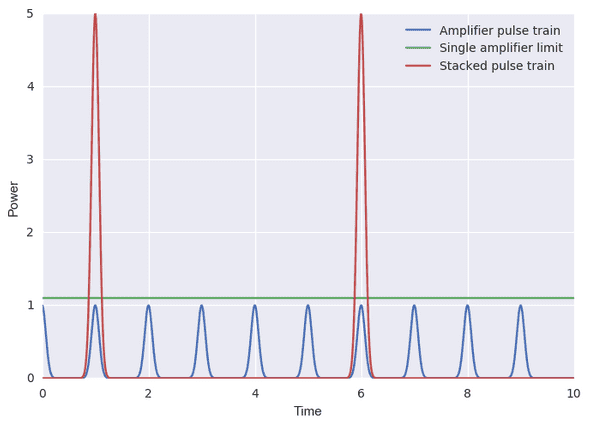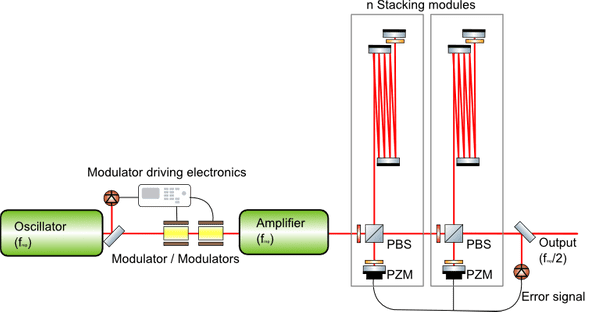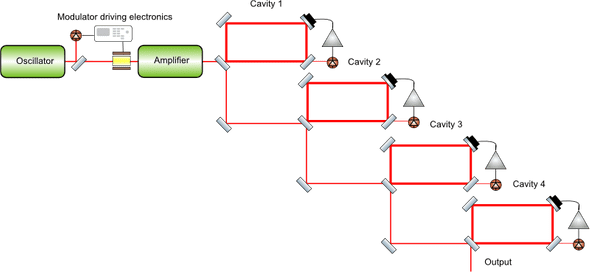Pulse Stacking
August 01, 2018
Fiber lasers can offer an efficient way towards hight average power, however pulsed laser systems usually suffer from the
long length of the fibers. This leads to nonlinearities, dispersion and Raman effects and generally degrades pulse quality. One way to reduce these effects is mode area scaling but this is limited due to modal instabilities. A very straightforward way is classic coherent beam combining, but in this case a large number of amplifiers needs to be built. If only the pulse energy/peak power has to be increased there has to be a better way. In fact there is: this is where temporal CBC is used. Temporal CBC uses the same idea of CBC but not in the spacial but in the temporal domain. The principle is very simple if we increase the repetition rate we can use more average power before running into peak power limitations. If we then find a way to combine the many pulses coming out of the amplifier to one high energy pulse we are not limited by the amplifier pulse energy limitation anymore. In theory this is a very attractive method but there are a few caveats that make this more difficult in practice. This article will discuss possible methods and challenges of various stacking techniques.

Methods
High finesse Cavity Stacking
At first glance the most attractive way of combining would be a cavity with a dumper. In principle a passive version of a regenerative amplifier which gets its power from the incoming pulse train. However this method suffers from the fact that a dumper is necessary. This dumper needs to be able to handle high pulse energy, high average power and be very low loss. And it simply does not exist yet. There have been some reports on this method - and if such a dumper can in fact be developed, this method might become the most popular one in the future. But for the time being it is not feasible - but with a great idea for the dumper you might be successful.

DPA, Delay Line Pulse Stacking, EDPA
Divided pulse amplification might be the first proposed method. In principle the method is very simple: before amplification the pulse is split up into multiple replica, which are then amplified individually and in the end the pulses are combined again. There are even passive versions of this methods using faraday rotators. The main challenge is that depending on the position of the pulse in the pulse burst, the amplification will also be different with the gain being slightly larger for the first pulse.
If you think about the splitting process, you will notice it relies on polarization and phase. It becomes clear that this can also be done by imprinting a phase shift on an already existing pulse train. This makes it simple to either use pulses as they come out of an oscillator - which are evenly spaced and therefore also do not suffer from the different gain dynamics or you design your frontend to emit pulse bursts and use the additional degrees of freedom to compensate for some of the asymmetric gain. Either way is not simple as either long delay lines or quite advanced driving electronics are necessary. One common challenge furthermore is the pulse contrast: as neither polarizers nor the control are perfect best extinction ratio demonstrated so far was limited to 21 dB.

Low finesse Cavities
An alternative to the polarizer/delay line approach is to use low finesse cavities for the delay - this method gave the idea for modern linear based stacking. A potential advantage is that instead of polarizers mirrors can be used and although the finesse should not be very large for this to work, the pulse on average stays in the GTI for more than one round trip which makes the delay lines shorter. Furthermore it offers more flexibility which makes designs possible which cannot be reproduced by the delay line design. However the flexibility can be a blessing and a curse as it also makes the control and design of such a system more challenging. Theoretically very hight extinction ratios can be achieved with this method but those have not been shown experimentally yet.

Challenges
The main challenge all of these methods suffer from is that they need to store energy and can not use any material to do it. Here the hight finesse cavity has a clear advantage but even there many round trips lead to losses and aberrations. This is why if possible energy storage in the active medium is often beneficial.